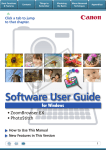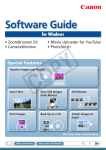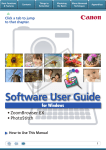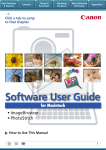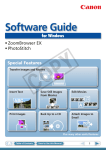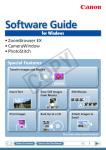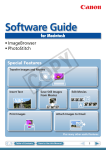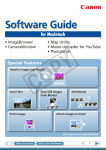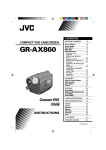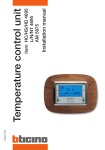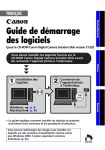Download Canon A470 Software Guide for Windows
Transcript
Basic Functions & Features Contents Things to Remember Mastering the Basics More Advanced Techniques Appendices Click a tab to jump to that chapter. Y P O C Software User Guide for Windows •ZoomBrowser EX •PhotoStitch How to Use This Manual New Features in This Version 1 Basic Functions & Features Contents Things to Remember Mastering the Basics More Advanced Techniques Appendices About this Manual Notation Conventions The contents of this manual are classified according to the following symbols. IMPORTANT •The “Important” sections contain operating precautions or important topics. Ensure that you read them. HINT • The “Hint” sections contain procedural suggestions and tips for your convenience. Read them as necessary. Operating Environment Y P O •This manual uses Windows XP screen shots and procedures in the explanations. The screen shots and procedures may appear slightly different if you are using another version of Windows. • The displayed screens and procedures may also differ slightly from the examples depending upon the camera or printer model in use. •The explanations in this guide are based on the premise that a Canon compact camera will be used with the software. Word Searches C This document is provided as an Adobe Reader document. Use Adobe Reader’s Search functions to find specific words or phrases that you recall but cannot find. To access this function, in Adobe Reader click the [Edit] menu and select the [Search] option. If you are using Adobe Reader 8 or later, you can also perform searches with the [Find] function right on the toolbar. Input search text here 2 Basic Functions & Features Contents Things to Remember Mastering the Basics More Advanced Techniques Appendices This page and the next present the basic functions of ZoomBrowser EX as well as some of its special features. To Download Downloading (p. 10) Download images with a single click. To Print Print with the layouts you want. Printing (p. 13) 100-0032 100-0031 100-0034 100-0033 9/09 200X/0 To View Magnifying the Display (p. 21) Comparing Images (p. 40) To Organize 100-0036 100-0035 C Y P O 100-0038 100-0037 Displaying Shooting Information (p. 21) Slideshows (p. 34) Backing Up to a CD (p. 32) Changing File Names in Batches (p. 35) Using Star Ratings (p. 36) Deleting (p. 19) Using Comments (p. 36) Performing Searches (p. 38) ABC ABC 123 XYZ xxx_01 xxx_02 xxx_03 Next 3 Basic Functions & Features Things to Remember Contents Mastering the Basics More Advanced Techniques Appendices To Edit Adjusting Color and Brightness (p. 23) Inserting Text (p. 24) Converting RAW Images (p. 28) Red-Eye Correction (p. 22) Trimming (p. 24) TEXT RAW Formatting Images as Wallpaper (p. 31) Resizing Images (p. 29) Merging Images into Panoramas (p. 27) Y P O Extracting Still Images from Movies (p. 30) C Editing Movies (p. 27) ABC To Connect to a Camera Uploading to a Camera (p. 45) Configuring My Camera Settings (p. 43) You can change the camera’s start-up image and shutter sound. Controlling Shooting from the Computer (p. 41) To Send Email Attaching Images to Email (p. 33) You can reduce image file sizes. Previous 4 Basic Functions & Features Contents Things to Remember Mastering the Basics More Advanced Techniques Appendices Table of Contents About this Manual.......................................................................................................... 2 Basic Functions & Features............................................................................ 3 Things to Remember..................................................................................... 7 The Two ZoomBrowser EX Windows............................................................................ 7 Download Window/Organizing Window................................................................ 7 Main Window................................................................................................................. 8 How to Display the Main Window........................................................................... 8 Names of the Main Window Parts............................................................................ 8 How to Perform Tasks.................................................................................................... 9 Selecting Tasks and Task Window Procedures......................................................... 9 Y P O Mastering the Basics................................................................................... 10 Downloading Images................................................................................................... 10 Downloading Images by Connecting the Camera to a Computer....................... 10 Printing.......................................................................................................................... 13 Printing a Single Image on a Single Page.............................................................. 13 Index Print................................................................................................................ 15 How to Use CameraWindow....................................................................................... 17 First Window to Open............................................................................................. 17 Screen Showing the Image Index List and Image View......................................... 18 How to Use the Main Window.................................................................................... 19 Main Window.......................................................................................................... 19 Browser Area Tasks ................................................................................................. 20 Viewer Window....................................................................................................... 21 C More Advanced Techniques........................................................................ 22 Editing Images.............................................................................................................. 22 Red Eye Correction.................................................................................................. 22 Auto Adjustment..................................................................................................... 22 Color/Brightness Adjustment.................................................................................. 23 Adjusting Sharpness–Emphasizing Outlines.......................................................... 23 Trimming–Cropping a Portion of an Image........................................................... 24 Inserting Text........................................................................................................... 24 Using Other Editing Software................................................................................. 25 Attaching Sounds.................................................................................................... 26 Creating Panoramic Images–PhotoStitch............................................................... 27 Editing Movies......................................................................................................... 27 Converting RAW Images......................................................................................... 28 5 Basic Functions & Features Contents Things to Remember Mastering the Basics More Advanced Techniques Appendices Exporting....................................................................................................................... 29 Changing Image (Stills) Sizes and Types................................................................. 29 Changing Movie Sizes and Types............................................................................ 29 Extracting Stills from Movies.................................................................................. 30 Exporting Shooting Information............................................................................ 30 Creating Computer Screen Saver Images .............................................................. 31 Creating Computer Wallpaper Images................................................................... 31 Saving to CDs........................................................................................................... 32 Email.............................................................................................................................. 33 Attaching Images to Email...................................................................................... 33 Slide Shows................................................................................................................... 34 Viewing Images in Slide Shows............................................................................... 34 Image Management..................................................................................................... 35 Changing File Names in Batches . .......................................................................... 35 Sorting Images into Folders by Shooting Date...................................................... 35 Configuring Image Information Settings.................................................................... 36 Setting Star Ratings................................................................................................. 36 Inserting Comments................................................................................................ 36 Assigning Keywords................................................................................................ 37 Searching, Filtering and Sorting Images..................................................................... 38 Searching Images..................................................................................................... 38 Filtering Images....................................................................................................... 39 Sorting Images......................................................................................................... 39 Comparing Images........................................................................................................ 40 Comparing Multiple Images................................................................................... 40 Remote Shooting.......................................................................................................... 41 Operating the Camera Using Computer Commands............................................. 41 My Camera Settings..................................................................................................... 43 Changing the Shutter Sound and Start-Up Image................................................ 43 Uploading Images......................................................................................................... 45 Uploading Images to a Camera.............................................................................. 45 Preference Settings....................................................................................................... 46 Customizing ZoomBrowser EX................................................................................ 46 Customizing the Task Buttons................................................................................ 46 C Y P O Appendices................................................................................................... 47 Supported Image Types................................................................................................ 47 New Features in This Version....................................................................................... 48 6 Basic Functions & Features Things to Remember Contents Mastering the Basics More Advanced Techniques Appendices The Two ZoomBrowser EX Windows Download Window/Organizing Window The following two windows are the main ones used for ZoomBrowser EX procedures. Download window, which opens when a camera is connected. CameraWindow View of camera images C Y P O You can download all or a selection of images from the connected camera. CameraWindow closes and the screen changes after the images are downloaded from the camera. Organizing window for downloaded images. Main Window Double-click this icon on the desktop. Double-click an image. You can view, edit and print the images in the computer. The Viewer Window that appears when you view an image. 7 Basic Functions & Features Things to Remember Contents Mastering the Basics More Advanced Techniques Appendices Main Window How to Display the Main Window The Main Window will display after camera images are downloaded and CameraWindow closes. You can also display it by double-clicking the ZoomBrowser EX icon on the desktop. Names of the Main Window Parts Function Buttons Menu Bar Task Buttons Selects tasks to perform. C Last Acquired Images Displays the last images downloaded. Display Control Panel Y P O Folder Area Selects a folder to display. Properties Icon (Displays image properties) : Image recorded using the camera’s Stitch Assist mode : RAW image : Movie : Image with sound memo attached : Protected image : Image recorded using the camera’s AEB function : Rotated image (rotated in display only) Browser Area Icons that indicate image properties display around images, as shown on the left. 8 Basic Functions & Features Things to Remember Contents Mastering the Basics More Advanced Techniques Appendices How to Perform Tasks Selecting Tasks and Task Window Procedures Many ZoomBrowser EX functions can be accessed by selecting a task in the Main Window and following the instructions in the guidance section of the new window. 1 Select a task. Y P O The major steps for the task appear here. Follow the steps in order. You can return to a previous step. C An overview for the selected task appears here. Cancels the procedure and returns to the previous window. 2 Follow the instructions to perform the task. 9 Basic Functions & Features Contents Things to Remember Mastering the Basics More Advanced Techniques Appendices Downloading Images Downloading Images by Connecting the Camera to a Computer Download the camera images to the computer. Y P O IMPORTANT •The instructions in this software manual assume that you have correctly installed the software and driver software. See the guides supplied with your product package for software installation procedures. •With some versions of Microsoft Windows, CameraWindow may not open when the camera is connected. In this case, double-click the ZoomBrowser EX icon on the desktop to start ZoomBrowser EX and open the Main Window. Click the [Acquire & Camera Settings] task button, followed by [Connect to Camera]. C 1 Connect the camera to the computer with the supplied interface cable. 2 Turn on the camera power, set it to playback mode and prepare it to communicate with the computer. 3 When a window similar to the one at the right appears, select [Canon CameraWindow] and click [OK]. With Windows Vista, click [Downloads Images From Canon Camera using Canon CameraWindow] in the AutoPlay window. 10 Basic Functions & Features 4 Things to Remember Contents Mastering the Basics More Advanced Techniques Appendices CameraWindow Click [Transfer Untransferred Images]. The images will start to download. Y P O When you click [OK] in the dialog that indicates the transfer is complete, the downloaded images will display in the Main Window. You can select the newly downloaded images by their shooting dates or My Category (select models only) classification. (These are virtual folders.) C : Folders containing newly acquired images •Images from memory cards with large numbers of images (more than 1,000) may not download correctly. If this happens, please use a memory card reader to download. HINT Changing the Download Destination Folder The default settings save downloaded images into the [Pictures] or [My Pictures] folders. To change the destination folder, select [Operate Images on Camera] in CameraWindow, then click the button shown on the right, and select a folder. 11 Basic Functions & Features Things to Remember Contents Mastering the Basics More Advanced Techniques Appendices HINT Selecting Images to Download To download only a selection of images from the camera, select [Operate Images on Camera] in CameraWindow that first appears and then perform the following procedures. 1 Select images to download. 2 Start the download. C Y P O Downloading Using Camera Commands With Windows Vista or Windows XP, you can use the camera’s (Print/Share) button to download the images to the computer (Direct Transfer). See the Camera User Guide for Direct Transfer settings and procedures. Downloading from a Memory Card Reader An action selection window will open when you insert a memory card into the memory card reader. If you select [View/Download Images Using Canon ZoomBrowser EX], ZoomBrowser EX will start and display the following window. Use this window to perform the downloading procedures. Downloads all images that have not yet been downloaded. Allows you to select and download images. Prints images. Configures the download folder and other settings. 12 Basic Functions & Features Things to Remember Contents Mastering the Basics More Advanced Techniques Appendices Printing Printing a Single Image on a Single Page Prints one image per page. Y P O 1 Click the [Print & Email] task button in the Main Window. 2 Click [Photo Print]. 3 Confirm that [1. Select Images] is chosen and select images for printing. C 13 Basic Functions & Features 4 Contents Things to Remember Mastering the Basics More Advanced Techniques Appendices Click [2. Printer and Layout Settings] and set the categories as desired. Sets the printer, paper size and borderless printing settings. Click here to crop and print a portion of an image. Click here to insert text onto an image and print. C Y P O Sets the shooting date/time imprint settings. 5 Click [3. Print]. Printing will start. HINT Printing Using Other Software If you have specialized printing software installed on the computer, you can also use it to print the images. Click the [Print & Email] task button in the Main Window, followed by [Print Using Other Software]. 14 Basic Functions & Features Things to Remember Contents Mastering the Basics More Advanced Techniques Appendices Index Print Prints an index of the images. Y P O 1 Click the [Print & Email] task button in the Main Window. 2 Click [Index Print]. 3 Confirm that [1. Select Images] is chosen and select images for printing. C 15 Basic Functions & Features 4 Contents Things to Remember More Advanced Techniques Appendices Click [2. Printer and Layout Settings] and set the categories as desired. Sets the printer and paper size settings. Sets the number of rows or columns. 5 Mastering the Basics Click [3. Print]. Printing will start. Rotates selected images. C Click here to crop a portion of the selected image and print it. Y P O Select an image to rotate or trim. Configures the printing of the shooting information, comments, headers, footers or page numbers. 16 Basic Functions & Features Contents Things to Remember Mastering the Basics More Advanced Techniques Appendices How to Use CameraWindow First Window to Open This is the first screen to appear in CameraWindow. Y P O Downloads all images that have not yet been downloaded. Closes this window and opens a camera image browser window that lets you select and download images. C 17 Basic Functions & Features Things to Remember Contents Mastering the Basics More Advanced Techniques Appendices Screen Showing the Image Index List and Image View The Thumbnail Window on the left of the screen displays the images on the memory card in the camera as “thumbnails” or small versions of the images in an index list. When you select an image from the Thumbnail Window, the image displays in the View Window on the right. Configures settings such as the thumbnail size and download folder. Aligns the windows. Switches between window display modes. Thumbnail Window Configures the name of the camera owner. View Window C Y P O Uploads computer images to the camera. Closes CameraWindow. Selects all images/images not yet downloaded. Downloads images selected in the Thumbnail Window. Prints images selected in the Thumbnail Window. These arrows switch the image in the View Window. HINT Use the Help Function The Help button or Help menu is available in most ZoomBrowser EX windows. It is there for when you are unsure how to proceed. 18 Basic Functions & Features Things to Remember Contents Mastering the Basics More Advanced Techniques Appendices How to Use the Main Window Main Window This is the main window for performing tasks in ZoomBrowser EX. Delete Deletes the selected images or folders. • Deleted images are sent to the Recycle Bin on the desktop. • The association between a sound memo and an image cannot be recovered from a file restored from the Recycle Bin. Search Performs searches on images. Slide Show Displays the selected images in succession in the window. Properties Displays information about a selected image. Rotate Rotates a selected image. • Click the [Edit] menu and select [Rotate According to Rotation Information] to rotate the original image as well in the displayed direction. • Movies can be rotated by clicking the [Export] task button followed by [Export Movie]. View Image Displays the selected image in the Viewer Window. Task Buttons Selects a task to perform. C Last Acquired Image/Folder Area Selects a folder to display. • You can register folders you use ). often as Favorite Folders ( Register by clicking [Add]. Y P O Browser Area Displays the images in an index list. Display Control Panel Configures the settings for displaying images in the Browser Area. 19 Basic Functions & Features Things to Remember Contents Mastering the Basics More Advanced Techniques Appendices Browser Area Tasks Display Mode Selects a display mode for the Browser Area. Zoom Mode: suited for surveying many images. Scroll Mode: allows thumbnails to be viewed at a size suited for easy viewing. Change the Folder Level The level of folder displayed can be changed with the following procedures. • In Zoom mode, position the mouse cursor over the folder and click the icon when it displays. • In Scroll or Preview mode, double-click the icon. • To advance to a higher folder level, click the icon. C Y P O Preview Mode: allows the image information to be read while viewing the image. Change the Display Size You can change the display ratio (Zoom mode) or thumbnail size (Scroll mode) with the slider. Select Images Clicking an image in the Browser Area selects that image. To select multiple images, hold down the [Ctrl] key while clicking images, or hold down the [Shift] key and click a starting and ending image to select a range of adjacent images. Display Images Double-clicking an image in the Browser Area (or selecting the image and clicking displays it in the Viewer Window. Create New Folder To create a new folder in the Browser Area, click the [File] menu and select [New Folder]. (Display Image)), Move, Copy Images To move an image between folders, drag it over the destination folder and release the mouse button. To copy an image, hold the [Ctrl] key while releasing the mouse button as above. You can also use the same procedures to copy images between Windows Explorer and the Main Window. HINT Right-Click Context Menus Right-clicking over a window or image displays contextual menus. These menus contain the functions available in the current context as well as other convenient functions. Use the right-click menus to increase your efficiency. 20 Basic Functions & Features Things to Remember Contents Mastering the Basics More Advanced Techniques Appendices Viewer Window Double-clicking an image in the Main Window displays it in this window. Change the display magnification. Zooming in displays the Navigator window to show the relative position on the image. Edit an image. Display the shooting information. You can configure the information display by clicking the [Tools] menu and selecting [Preferences]. Display multiple images side by side. Display at full screen size. Set the Star Rating. C Y P O Shooting information •The [Display Original Image] button will display beneath RAW images in the Viewer Window. Click this button to display the converted image in the Viewer Window. •Buttons appear beneath movies selected in the Viewer Window, allowing you to replay the movie or adjust the sound volume. With Windows Vista and Windows XP, the (Frame Capture) button will appear beside the Star Rating section. Clicking this button extracts still images from the movie. 21 Basic Functions & Features Things to Remember Contents Mastering the Basics More Advanced Techniques Appendices Editing Images IMPORTANT •The original image will be overwritten after an image is edited unless the file name is changed before saving it. To preserve the original image intact, change the file name when saving the edited image. •This section introduces the procedures started by clicking the Edit task button. Images can also be edited in a similar way by clicking the [Edit] button in the Viewer Window. Red Eye Correction Restores eye appearance to the original color when light reflected from the flash makes them appear red. Y P O Procedures 1 C •Click [Start] when Auto mode is selected. •Switch to Manual mode if Auto mode cannot correct the image and select the location of the eye to correct. Auto Adjustment 2 3 4 5 [Edit] and [Edit Image]. Select an image. [2. Select Editing Tool] [Red Eye Correction] [3. Finish] •Movies and RAW images cannot be edited. Automatically adjusts the image color balance and brightness. Procedures 1 2 3 4 5 [Edit] and [Edit Image]. Select an image. [2. Select Editing Tool] [Auto Adjustment] [3. Finish] •Movies and RAW images cannot be edited. 22 Basic Functions & Features Things to Remember Contents Mastering the Basics More Advanced Techniques Appendices Color/Brightness Adjustment You can adjust image color balance and brightness using a variety of methods. Brightness, Saturation, Contrast Procedures 1 RGB Adjustment 2 3 4 Level Adjustment 5 Tone Curve Adjustment [Edit] and [Edit Image]. Select an image. [2. Select Editing Tool] [Color/Brightness Adjustment] [3. Finish] Y P O •Movies and RAW images cannot be edited. C Adjusting Sharpness–Emphasizing Outlines Makes images appear sharper by emphasizing the outlines of subjects, such as people and objects. Sharpen Unsharp Mask Procedures 1 2 3 4 5 [Edit] and [Edit Image]. Select an image. [2. Select Editing Tool] [Sharpness] [3. Finish] •The Unsharp Mask [Radius] is the size at which the outline is detected and the [Threshold] is the standard value at which the outline is determined. •Movies and RAW images cannot be edited. 23 Basic Functions & Features Contents Things to Remember Mastering the Basics More Advanced Techniques Appendices Trimming–Cropping a Portion of an Image Use this to delete unnecessary portions of the image and leave only the necessary portions. Procedures 1 2 3 4 5 [Edit] and [Edit Image]. Select an image. [2. Select Editing Tool] [Trim] [3. Finish] Y P O •You can also input values or an aspect ratio to specify the trim area. •Movies and RAW images cannot be edited. Inserting Text C Use this to insert text onto the image. You can freely adjust the font, size, color and text attributes. HELLO Procedures 1 2 3 4 5 [Edit] and [Edit Image]. Select an image. [2. Select Editing Tool] [Insert Text] [3. Finish] •Placing a checkmark in the [Antialias] box causes the text edges to blend in with the underlying image. •Movies and RAW images cannot be edited. 24 Basic Functions & Features Contents Things to Remember Mastering the Basics More Advanced Techniques Appendices Using Other Editing Software If you register another image editing program with ZoomBrowser EX in advance, you can use that software to edit an image selected in ZoomBrowser EX. Registering an Editing Program Procedures Register the program so it can be started from within ZoomBrowser EX. ZoomBrowser EX 1 Other Image Editing Program 2 3 4 [Edit] and [Edit Image]. Select an image. [2. Select Editing Tool] [Edit with external image editor] [Manage List] Y P O 5 Editing Images with a Registered Editing Program C Procedures 1 2 3 4 5 [Edit] and [Edit Image]. Select an image. [2. Select Editing Tool] [Edit Image Using Other Editor] [3. Finish] •The shooting information may be lost from images recorded with the camera and then processed and saved with another image editing program. •Movies and RAW images cannot be edited. 25 Basic Functions & Features Things to Remember Contents Mastering the Basics More Advanced Techniques Appendices Attaching Sounds You can add sound effects or background music to images and play back the sounds. Adding Sound Procedures + 1 2 Symbol displayed on image thumbnails to which sound files have been added. Playing an Image Sound File C Select an image. [Edit] and [Add/Remove Sound]. Y P O •WAVE type sound files (extension “.wav”) can be attached to images. •Attaching a sound file to an image results in the selected sound file being copied into the same folder as the image file. Procedures 1 2 Select an image. [Edit] and [Play Sound]. 26 Basic Functions & Features Contents Things to Remember Mastering the Basics More Advanced Techniques Appendices Creating Panoramic Images–PhotoStitch You can create wide panoramic images by moving the camera slightly when recording a series of images and merging them into one image. Procedures 1 [Edit] and [Stitch Photos]. •Movies and RAW images cannot be edited. Use the PhotoStitch program to create panoramic images. HINT Y P O Using the Stitch Assist Mode If you use the camera’s Stitch Assist mode to record the images, PhotoStitch can automatically detect the image order and merge direction, making it easier to merge the images. (Some camera models may not feature the Stitch Assist mode.) Editing Movies C You can create original movies by linking movie clips and still images. You can even add titles and other text, background music and various special effects to the movie. ABC Procedures 1 [Edit] and [Edit Movie]. IMPORTANT QuickTime is required to play movies on Windows 2000. 27 Basic Functions & Features Things to Remember Contents Mastering the Basics More Advanced Techniques Appendices Converting RAW Images You can convert RAW images to JPEG and TIFF images. Image type retaining the detailed image data from the initial capture. Image type suited for pasting into word processing documents and general programs, and for sending by email. RAW Procedures 1 [Edit] and [Process RAW Images]. JPEG, TIFF... •You can use the Image Quality Adjustment Window to adjust the image brightness and color to your satisfaction. Exposure correction Color adjustment Lossless image adjustments possible Y P O White balance adjustment Color space configuration HINT C About RAW Images RAW images contain the data captured by the camera’s image sensor without modification. Since they contain raw data that differs from the usual JPEG images by not having any image adjustment or compression processing performed in the camera, they can be converted on a computer with a lossless process. Processing in the Camera Standard Image Capture Image sensor data from shutter release RAW Image Capture Processing by Computer Image Adjustment Compression JPEG Image Image adjustment & compression automatically performed • Can be used with general programs. • Image is subject to degradation when adjusted because it has been compressed. ZoomBrowser EX RAW Image Processing RAW Image Image Adjustment Compression JPEG Image, TIFF Image • You can view the image while making adjustments without worrying about quality loss. • Processing with ZoomBrowser EX is required to view the images with general programs. IMPORTANT •RAW images can only be captured on certain camera models that list “RAW” as one of the data types included in the “Specifications” section of the Camera User Guide. 28 Basic Functions & Features Contents Things to Remember Mastering the Basics More Advanced Techniques Appendices Exporting Changing Image (Stills) Sizes and Types You can change an image’s size and format when exporting it so that it can be published on the Internet or attached to an email message. Procedures 1 [Export] and [Export Still Images]. Y P O •You will lose the shooting information if you save images as a type other than JPEG. .bmp .jpg .tif C Changing Movie Sizes and Types You can change a movie’s size and format when exporting it so that it can be published on the Internet or attached to an email message. Procedures 1 [Export] and [Export Movies]. •You can also use this function to rotate movies. .avi IMPORTANT •The QuickTime program is required to play movies on Windows 2000. 29 Basic Functions & Features Things to Remember Contents Mastering the Basics More Advanced Techniques Appendices Extracting Stills from Movies You can extract and save stills from your favourite frames recorded in a movie. (Windows Vista and Windows XP only) Procedures 1 [Export] and [Extract frames from a movie]. Extract your best shots as stills Y P O Exporting Shooting Information C You can export the shooting information recorded with an image, such as the shutter speed and exposure, as a text file. Procedures 1 [Export] and [Export Shooting Properties]. Ascertain the causes of failed photos or compare the settings for several images. 30 Basic Functions & Features Contents Things to Remember Mastering the Basics More Advanced Techniques Appendices Creating Computer Screen Saver Images You can export images to serve as computer screen savers. Procedures 1 [Export] and [Export as a Screen Saver]. Y P O Creating Computer Wallpaper Images You can export images to serve as computer wallpaper images. C Procedures 1 [Export] and [Export as a Wallpaper]. 31 Basic Functions & Features Contents Things to Remember Mastering the Basics More Advanced Techniques Appendices Saving to CDs You can save images along with their shooting information to CD-R/RW discs. (Windows Vista and Windows XP only) Procedures 1 [Export] and [Backup to CD]. Back up important images or distribute your vacation photos on discs. Y P O IMPORTANT •This function can only be used with computers that satisfy the following requirements: C •Equipped with a CD-R/RW drive as standard equipment •Writing to the CD-R/RW drive operates correctly with Windows Vista or Windows XP. •If a window similar to that shown to the right appears when a new CD-R/RW disc is placed in the drive, click [Cancel] to close the window. 32 Basic Functions & Features Contents Things to Remember Mastering the Basics More Advanced Techniques Appendices Email Attaching Images to Email You can send images as email file attachments. You can configure the image size and quality settings. Procedures 1 [Print & Email] and [Email Images]. •You can configure how the email program automatically starts up by starting the Internet Explorer program, and clicking the [Tools] menu, followed by [Internet Options], [Programs] tab, and the [E-mail] pull-down menu. C Y P O 33 Basic Functions & Features Things to Remember Contents Mastering the Basics More Advanced Techniques Appendices Slide Shows Viewing Images in Slide Shows A multiple selection of images can be shown at full size on the screen in succession as a slide show. You can freely configure the transition effects, information displayed and display time settings. Procedures 1 [View & Classify] and [View as a Slide Show]. HINT C Y P O Slide Show Button Functions The following buttons appear at the bottom of the screen while a slide show is playing. You can set the Star Rating for an image while it is displayed. After the slide show, the images you clicked during the show remain selected. Rewind Pause After the slide show, the images you clicked during the show appear in a printing window. Forward Stops the slide show. 34 Basic Functions & Features Things to Remember Contents Mastering the Basics More Advanced Techniques Appendices Image Management Changing File Names in Batches You can change the file names of multiple images in one procedure. Procedures 1 [View & Classify] and [Rename Multiple Files]. Name + Number Shooting Date + Number Name + Shooting Date + Number Shooting Date + Name + Number xxx_01 xxx_02 xxx_03 Y P O Change randomly numbered images and received images into consecutively numbered images. C xxx_04 •You can change individual file and folder names by clicking the [File] menu and selecting [Rename] or by clicking on the file name in Preview mode. •Changing the image name in ZoomBrowser EX also changes the actual file name on the disk. xxx_05 Sorting Images into Folders by Shooting Date You can sort images into folders by their shooting dates. Procedures 200x/05/15 200x/05/16 1 [View & Classify] and [Classify into Folder]. 200x/05/17 Images predating your use of ZoomBrowser EX can also be managed together. 35 Basic Functions & Features Things to Remember Contents Mastering the Basics More Advanced Techniques Appendices Configuring Image Information Settings Setting Star Ratings You can set the Star Ratings used in searching and displaying images in the index list. Procedures 1 2 : Ultimate : Moderate : Okay C Inserting Comments Switch to [Preview Mode]. Set [Star Rating]. •You can also set the Star Ratings by accessing the [Edit] menu, the Properties Window or the Viewer Window. Y P O You can freely insert your choice of text as Comments. Procedures 1 ite Endless wh hes sandy beac Trip to t he blue sea Relaxing afternoon snooze 2 Switch to [Preview Mode]. Insert [Comment]. •Comments can also be managed in the Properties Window. Your choice of text as comments 36 Basic Functions & Features Things to Remember Contents Mastering the Basics More Advanced Techniques Appendices Assigning Keywords You can set Keywords for use in image searches. Procedures 1 Family, s Animals Family, Trip Select keywords HINT 2 Friends, H olidays Switch to [Preview Mode]. Insert [Keywords]. •Keywords can also be managed from the [Tools] menu or Properties Window. •To add keywords, click the [Tools] menu and select [Manage Keywords]. Y P O About the Image Information This chart shows the information other than shooting information that can be added to images. Information Type Content Configuration Method My Category C Star Ratings Rated on basis of 3 Categories such as rankings: , , People, Scenery, etc. Configured in Camera Comments Keywords Text input without restriction regarding the shooting circumstances or associated memories. Selections are made from a list (editable) of keywords, such as the photographic subject, place or action. Configured in ZoomBrowser EX Used in Searches — O O O Used as Filter Criteria O O — — Display beneath Thumbnail O O O — Categories displayed beneath thumbnails can be selected by clicking in the Display Control Panel. 37 Basic Functions & Features Things to Remember Contents Mastering the Basics More Advanced Techniques Appendices Searching, Filtering and Sorting Images Searching Images You can search images using parameters extracted from the information associated with them. Procedures 1 [View & Classify] and [Search]. Star Ratings Keywords Comments •After a search, the correlated images display in the [Search Results] folder. Y P O Revision Dates Shooting Dates C HINT Tasks Related to Search Results You can select images in the [Search Results] folder and perform operations on them, such as printing or copying them to other folders. IMPORTANT •Please note that deleting an image from the [Search Results] folder deletes the original image. Use caution in deleting items from this folder. 38 Basic Functions & Features Things to Remember Contents Mastering the Basics More Advanced Techniques Appendices Filtering Images You can use filters to display only images meeting the selected parameters in the Browser Area. Procedures 1 [Filter] Star Ratings My Category Y P O This section is used to specify the filter criteria. Sorting Images C You can sort images in the Browser Area based on the specified parameters. D C A E B Name Type Shooting Date Modification Date A B Ascending/ Descending Order C Star Rating D Procedures 1 2 Select an image. [View] and [Sort by]. E 39 Basic Functions & Features Contents Things to Remember Mastering the Basics More Advanced Techniques Appendices Comparing Images Comparing Multiple Images When a good photo opportunity arises, you can shoot the same subject using different shutter speeds and exposures. In ZoomBrowser EX, it is easy to compare images so that minute differences can be detected. Procedures 1 Select several images to compare. 2 3 Click Y P O 4 C View Image. Select , or the Viewer Window. Click in Synchronize. •Selecting [Synchronize] causes actions such as increasing/reducing the magnification level or scrolling around the image to apply to all of the selected images in lock step, making it easy to check minute details of focus, coloring and other image characteristics. Actions, such as scrolling or changing the magnification, are performed on both images no matter which image it is performed upon. 40 Basic Functions & Features Contents Things to Remember Mastering the Basics More Advanced Techniques Appendices Remote Shooting Operating the Camera Using Computer Commands You can activate the shutter of a connected camera from the computer Also useful for fixed position or unmanned recording. Procedures 1 2 3 C Connect the camera to the computer. Turn on the camera power, and set it to playback mode. If the [Select program to launch for this action] (or AutoPlay) dialog opens, click [Cancel] (or in Windows Vista). If CameraWindow opens, click [Operate Images on Camera], followed by . Click [Start], followed by: [All Programs] or [Programs], [Canon Utilities], [CameraWindow], [RemoteCapture DC3], [RemoteCapture DC]. Y P O 4 IMPORTANT •Remote shooting is only available with certain camera models that list it as one of the features in the “Specifications” section of the Camera User Guide. •Ensure that you turn off your computer’s standby feature before you begin remote shooting. The results cannot be guaranteed if the computer enters the standby mode while remote shooting. •Except for the shutter button, the camera’s buttons and switches, including the zoom, cannot be manually operated while the camera is being remotely controlled. •The time lag between pushing the shutter button and the release of the shutter is slightly longer for remote shooting compared with the normal mode of operation. 41 Basic Functions & Features Contents Things to Remember Remote Shooting Window Selects the image’s recording size and compression. You can add a comment to an image. Mastering the Basics More Advanced Techniques Appendices Sets the rotation setting of the image being recorded. This setting cannot be adjusted if the [Auto Rotate] function of your camera is set to [On]. Releases the camera shutter (you can also release it by pressing the camera’s shutter button or the space bar on the keyboard). Viewfinder Sets the camera’s zoom. Turns the viewfinder display on or off. Y P O Resets the exposure, focus and white balance settings. Sets the shooting settings. HINT C Interval Timer Shooting This method captures a set number of frames recorded at set intervals of time. Click the [Shooting] menu in the remote shooting window and select [Interval Timer Shooting]. (Short intervals may be insufficient for image transmission and saving, resulting in the failure to capture images at the specified interval.) Timer Shooting This method captures a single image after a set number of seconds. Click the [Shooting] menu in the remote shooting window and select [Timer shooting]. The timer interval settings range from 2 seconds to 30 seconds. Displaying Subjects on the Camera’s LCD Monitor You can use the camera’s LCD monitor or a television connected to the camera to view the subject while shooting remotely. Click the [Camera] menu in the remote shooting window and select [Camera Display Settings]. See the Camera User Guide for TV connection instructions. Shooting Without Worrying about Memory Card Capacity Clicking the [File] menu in the remote shooting window and selecting [Preferences] opens the Preferences window. If you place a check mark beside [Computer only] in the [Save Images On] section, you can continue recording without worrying about free space on the camera’s memory card. 42 Basic Functions & Features Contents Things to Remember Mastering the Basics More Advanced Techniques Appendices My Camera Settings Changing the Shutter Sound and Start-Up Image The camera’s start-up image, start-up sound, shutter sound, operation sound and selftimer sound are collectively referred to as My Camera Settings. You can register your own custom images and sounds as the My Camera Settings. My Camera Settings • Start-up Image • Start-up Sound • Shutter Sound • Operation Sound • Selftimer Sound Procedures 1 2 Y P O 3 C Connect the camera to the computer. Turn on the camera power, and set it to playback mode. If the [Select program to launch for this action] (or AutoPlay) dialog opens, click [Cancel] (or in Windows Vista). If CameraWindow opens, click [Operate Images on Camera], followed by . Click [Start], followed by: [All Programs] or [Programs], [Canon Utilities], [CameraWindow], [MyCamera], [MyCamera]. Click [Connect to Camera]. 4 5 IMPORTANT •My Camera Settings are only available with certain camera models that list them as features in the “Specifications” section of the Camera User Guide. •Do not interrupt the connection between the camera and computer when My Camera Settings are being transmitted between them. •With Windows Vista, the settings files originally supplied with ZoomBrowser EX cannot be deleted. 43 Basic Functions & Features Contents Things to Remember Mastering the Basics More Advanced Techniques Appendices You can register the start-up image, start-up sound, shutter sound, operation sound and self-timer sound collectively if you select [Setup as a theme]. My Camera Settings in the computer. HINT My Camera Settings registered in the camera. C Y P O After selecting a My Camera Settings file from the left-hand list, select a My Camera Settings file to replace in the right-hand list and click this button to register it in the camera. Creating My Camera Settings You can create your own original My Camera Settings files using My Camera Maker, a supplied program. To start My Camera Maker, select the [Set individually] tab in the My Camera window and click [Create My Camera data]. * The volume control knob in My Camera Maker sets the volume level in the saved sound file itself. If you think the volume is too loud when replayed on the computer and set it low when you save the file, the sound may not be audible when it is registered to the camera. To adjust the playback volume on the computer, please use the volume controls for the computer or speakers. Use the following specifications to create My Camera Settings files if you are using an alternative program to My Camera Maker. Start-up images: Compression Method: JPEG (Baseline JPEG) Data Sampling: 4:2:0 or 4:2:2 Pixels (w x h): 320 x 240 pixels Sound files: Type Duration in Seconds 11.025 kHz 8.000 kHz Start-Up Sound 1.0 sec. or less 1.3 sec. or less Compression Method: WAVE (Monaural) Operating Sound 0.3 sec. or less 0.4 sec. or less Quantifying Bits: 8 bit Self-Timer Sound 2.0 sec. or less 2.0 sec. or less Sampling Frequency: 11.025 kHz or Shutter Sound 0.3 sec. or less 0.4 sec. or less 8.000 kHz (Use the chart on the right as a guideline for the length of sound files recorded with the camera.) 44 Basic Functions & Features Things to Remember Contents Mastering the Basics More Advanced Techniques Appendices Uploading Images Uploading Images to a Camera You can upload images from a computer to a memory card in a camera. Procedures 1 2 3 Show favorite images to friends or connect a TV to show them on a large screen. C Connect the camera to the computer. Turn on the camera power, and set it to playback mode. Select [Canon CameraWindow] (with Windows Vista, select [Downloads Images From Canon Camera using Canon CameraWindow]. Click [Operate Images on Camera]. Y P O 4 5 Click (Send to Camera). •If the Main Window is open when the camera is connected (directly after downloading for instance), open CameraWindow by clicking the [Acquire & Camera Settings] task button, followed by [Connect to Camera]. IMPORTANT •Only images compliant with Design rule for Camera File system standards can be uploaded to your camera’s memory card. 45 Basic Functions & Features Contents Things to Remember Mastering the Basics More Advanced Techniques Appendices Preference Settings Customizing ZoomBrowser EX You can configure ZoomBrowser EX to operate according to your preferences. • Overall themes, such as window appearances • Processing methods for images shot with the camera on end • Categories of shooting information displayed • Show/hide messages • Print settings • Zoom speed C Procedures 1 [Tools] and [Preferences]. Y P O Customizing the Task Buttons You can hide items that you do not usually use to streamline the task buttons. Procedures 1 [Tools] and [Customize]. 46 Basic Functions & Features Things to Remember Contents Mastering the Basics More Advanced Techniques Appendices Supported Image Types The following is a list of image types supported by ZoomBrowser EX. JPEG (.JPG) Most cameras use this image type. It compresses at very high ratios, taking advantage of the characteristics of the human eye. However, because it is an irreversible compression method (part of the data is lost during compression), if you process and save an image repeatedly using this method, the image may become rougher. RAW (.CRW/.CR2) This is a proprietary image type provided by Canon. It saves the output of the image pixels from a digital camera without any deterioration in the quality of the image. Some cameras might not support this image type. Windows bitmap (.BMP) Y P O This image type comes standard with Windows. Most Windows programs support it. TIFF (.TIF) C This is a relatively popular image type. It is widely supported by non-Windows programs (such as Macintosh). PhotoCD (.PCD) This is the image type used for Photo CDs. Video clip (.AVI) Standard Windows movie image type. The movie thumbnail and a movie icon show in ZoomBrowser EX’s Browser Area. QuickTime (.MOV) This is a movie which displays as a movie icon in the Browsing Area of ZoomBrowser EX. MPEG4 (.ASF) Movies that integrate multimedia data, such as video, audio and text. Primarily used by Windows programs. The MPEG4 compression technology allows for compact file sizes and delivery over networks. 47 Basic Functions & Features Contents Things to Remember Mastering the Basics More Advanced Techniques Appendices New Features in This Version The following features were added or changed in this version of ZoomBrowser EX. (ZoomBrowser EX Ver. 5.8 to 6.1) CameraWindow Makeover CameraWindow has been completely revamped to make the linkage tighter between Canon brand cameras and ZoomBrowser EX and to add convenience and functionality. It may not be possible to use the new CameraWindow with some camera models. Changes to Memory Card Downloading Methods The Camera Control Window was used in prior versions to download images from memory card readers. These downloads are now performed as a ZoomBrowser EX task in the Main Window. The data reading speed has also been significantly accelerated. Y P O Text Insertion Feature Added to Printing Functions In addition to the ability to print such information as the shooting date with the image, you are now able to add text freely during the printing preparation. Greeting cards and photos bearing messages can now be made with ease. Task Button Revisions C The task button composition has been revised to make the tasks more intuitive. •The starting point for the “Sending images by email” process has shifted from the [Internet] button to the [Print & Email] button. 48 Basic Functions & Features Contents Software User Guide Things to Remember More Advanced Techniques Appendices Y P O Windows C Mastering the Basics (ZoomBrowser EX, PhotoStitch) Disclaimer •While every effort has been made to ensure that the information contained in this guide is accurate and complete, no liabilitycan be accepted for any errors or omissions. Canon reserves the right to change the specifications of the hardware and software described herein at any time without prior notice. •No part of this guide may be reproduced, transmitted, transcribed, stored in a retrieval system, or translated into any language in any form, by any means, without the prior written permission of Canon. •Canon makes no warranties for damages resulting from corrupted or lost data due to a mistaken operation or malfunction of the camera, the software, memory cards, personal computers, peripheral devices, or use of non-Canon memory cards. Trademark Acknowledgments •Microsoft, Windows Vista and the Vista logo are trademarks or registered trademarks of Microsoft Corporation in the United States and/or other countries. •Macintosh, the Mac logo, QuickTime and the QuickTime logo are trademarks of Apple, Inc., registered in the U.S. and other countries. CDA-E015-010 © CANON INC. 2008 49

















































